Persistent cutaneous flushing associated with presumed renal neoplasia in a dog
There are lots of dogs out there with diffuse or macular erythema, petechiae, ecchymoses and other varieties of ‘red skin’. ‘Flushing’ is a term used to describe erythema in people caused by vasodilation: it is usually transient and benign. Persistent flushing is somewhat more worrying.
The present case involves a 9 y.o. FN Labrador with dramatic, widespread erythema of one month’s duration. There was no apparent pruritus. She had no history of dermatological problems but had lost 1.5Kg bodyweight since the onset of skin signs. There was no history of preceding medication and no correlation between signs and the intermittent use of various medications during treatment.
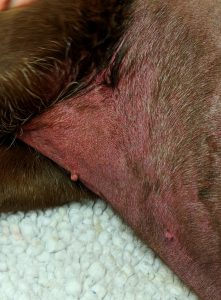
Flushing of the ventral abdomen: it’s difficult to capture accurately the degree of intense erythema in the face of fluorescent lighting and automatic camera adjustments. The skin was diffusely deep red-purple.
Almost the whole skin surface is involved including pinnae and ear canals. Oral mucous membranes were not affected.
In people, potential causes for persistent flushing include mastocytosis, medullary thyroid carcinoma, pheochromocytoma, renal cell carcinoma, and various other rare carcinomas. Almost nothing is published on similar phenomena in dogs:
Miller, W.H., Jr (1992) Cutaneous flushing associated with intrathoracic neoplasia in a dog. J Am Anim Hosp Assoc 28, 217–9
Sonography revealed multiple large, vascular, hypoechoic mass lesions in both kidneys:
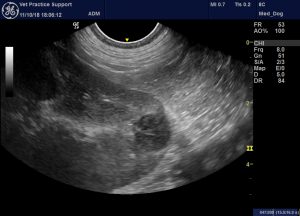
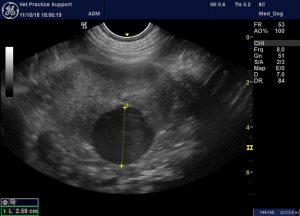
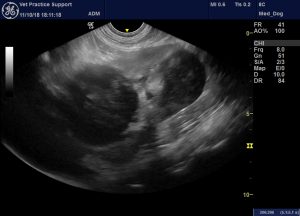
Her owners declined further investigation and, thus, a definitive diagnosis was not reached. However, a plausible explanation seems to be that these lesions are renal neuroendocrine tumours. These are reported in a wide range of organs and have the potential to release vasoactive agents such as serotonin.
Flushing is a classic feature of carcinoid syndrome in people:
https://en.wikipedia.org/wiki/Carcinoid_syndrome
This is inevitably speculation but there is a certain subjective similarity between the renal lesions in the present case and histopathologically-confirmed carcinoids in other patients we have seen:
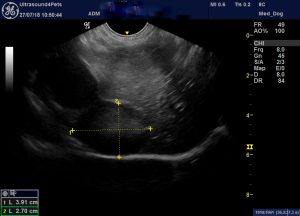
Hepatic carcinoid in a Cocker spaniel: it is our observation that neuroendocrine tumours are often very discrete, rounded, homogeneous lesions.





